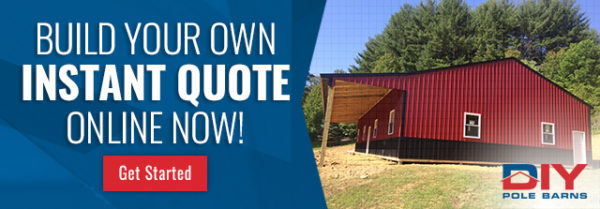Pole barns are used for all sorts of purposes, from pole barn garages to building pole barn hobby shops and workshops. But one of the most common uses for a pole barn is to keep livestock. When the hottest days of summer finally arrive, everyone with barns for livestock must make sure that their animals are safe from the heat.
If you’re thinking of building a pole barn for livestock, or are thinking your current pole barn isn’t adequately designed, read on to learn about keeping your pole barns cool in the summer heat.
Popular Ways to Keep Your Livestock Cool
Ground or Mounted Fans
A relatively inexpensive solution, fans are one of the most popular ways to help keep a pole barn cool for livestock. While smaller livestock like chickens can be cooled with more convenient, consumer-grade fans, it’s important to remember that a barn of large livestock needs a large fan. Fortunately, these can often be purchased through the nearest local farm supply store.
How the fans are installed matters too. The safest way is to mount them high on the walls or ceilings – especially when your livestock is smaller. Chickens or any winged animals can easily be harmed if the fans are in reach due to their slim wings and feathers. If you decide to leave fans on the ground, make sure they’re blocked off from wandering livestock but aren’t too obstructed, impacting their effectiveness.
Just make sure any electrical systems you plan to run to your pole barn satisfy your area’s building electrical codes! They vary greatly, so take the time to speak with a professional or sit down and review them yourself to get familiar before you finalize your plan.
Use a Misting/Spraying System
Introducing a steady volume of water and moisture into the area, barn misting systems are a popular way to improve the health of livestock. The effectiveness of a misting system depends highly on the airflow in the barn because misting as a cooling solution relies on evaporation. The less airflow, the less evaporation. Not only can this impact its effectiveness for cooling, it can also leave your barn damp.
Mists also do more than just cool the area. The added moisture helps reduce airborne particles like dust, which can help prevent respiratory issues. In dry regions, the added moisture in the air is also helpful to make the animals more comfortable. Lastly, the misting acts as a deterrent for small insects and helps keep them away from your livestock.
Fresh Drinking Water
Water is, of course, critical for your livestock. But not any water will do; keep your livestock barn well-stocked with clean, cool water that’s refreshing and safe. Watering troughs should be placed away from direct sunlight to help keep them from becoming stagnated. This is important because warm, stagnate water won’t help with temperature regulation and it increases the opportunity for bacteria.
Many pole barn owners opt to install automatic waterers that refill with cool, fresh water when needed. If you’re not able to do that, you can also freeze large containers of water and leave these massive ice blocks in the watering troughs to help regulate the water temperature throughout the morning.
The Importance of Airflow for Your Livestock Pole Barn
When designing your pole barn, start by considering the air flow and ventilation needs of your livestock. There are many reasons that proper airflow is important, such as:
- Improving air quality
- Reducing heat generated by livestock
- Removing noxious gases produced by livestock
- Removing contaminants and dust from the air
The best way to maximize airflow in your pole barn is to include windows and ventilation options. DIY Pole Barn’s kits can include additional features like a continuous ridge vent that aids in overall ventilation and reduces condensation. Features like this are critical when designing pole barns for livestock.
Keeping an Eye Open for Heat Stress or Complications
When circumstances don’t allow for your livestock to stay properly cooled, it’s possible that they might start to show signs of heat stress or heat stroke. Especially for larger stock, like horses or cows, it’s crucial to know the signs so that you can mitigate any danger to their health. Here are some common signs of heat stress for larger livestock like cattle or horses:
- Panting, slobbering or open-mouth breathing
- Tightly gathering under small spots of shade
- Eating less than usual
- Visibly uncoordinated or trembling
By the time your livestock is showing lack of coordination or trembling, they are likely reaching a peak in their heat episode and need quick attention. If you frequently feel like you’re intervening or even worrying about whether you need to or not, chances are your pole barn needs additional modifications for livestock.
Lock in a Quote for Your Pole Barn Workshop
If you’re ready to build your pole barn, lock in a quote with DIY Pole Barns using our Instant Quote tool! Have questions? Call our knowledgeable staff at (937) 547-9100.
Connect with us on social media!




